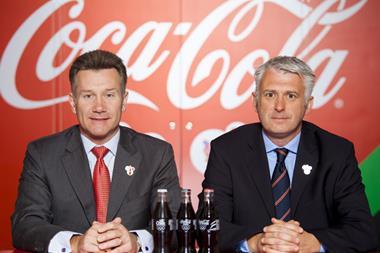Some Olympic sponsors are losing market share despite massive outlay - but does that mean they have been run off the track?
As British athletes finally start to rack up the golds, the Olympic sponsors may not be pinning medals on their marketing teams just yet.
And certainly not if they are judging performance purely on recent market share figures. Some sponsors - or sponsors’ brands - have lost share in their respective categories over the past six months compared with the same period a year ago, including Coca-Cola, Cadbury Dairy Milk, and P&G’s Pampers and Ariel.
These companies have forked out vast sums on sponsorship, bolstered by massive advertising spend - £15.1m on Coca-Cola and £6.7m on Gillette in the first half of the year, for example [Ebiquity] - so surely brand owners should expect an immediate sales boost?
Not necessarily. As far as commercial considerations go, one of the key reasons for securing an Olympic-scale sponsorship is to deny rivals the chance to take it on. “If you don’t do it your rivals will, and plenty of sponsorship is about ensuring they don’t get the opportunity to do so and gain commercial advantage,” says one senior industry figure.
While, ideally, sponsorships bring some short-term gain, activity on the scale of the Olympics is primarily about long-term benefit in terms of brand building. Only last week, Coca-Cola Enterprises MD Simon Baldry told The Grocer that the company’s sponsorship should be measured not on its performance in a single quarter but in terms of its lasting legacy.
It’s a view echoed by many industry observers, who say a brand that secures Olympic sponsorship in the hope of short-term gain may end up disappointed.
“A brand already has to be of some stature and has got to have something to say to get the most out of large-scale sponsorship - otherwise it can be a very expensive way of generating brand awareness,” says Peter Walshe, Global BrandZ Director at media research agency Millward Brown.
The primary reason for investing so heavily in such an event is to build on the messaging behind a brand, and to find new ways to talk to consumers. “Brand building is about getting people feeling passionate about a brand,” says Walshe. “Associating with an event people are passionate about helps to do this, and the Olympics has passion flowing out of it.”
Tapping into interests close to a consumer’s heart - whether through sport or the arts - gives a brand a way of getting past people’s defences, he adds.
This is an important ability at a time when consumers are increasingly wary and cynical of corporate sponsorship - an attitude not helped by activity such as McDonald’s much-publicised domination of chip sales in the Olympic park.
Coca-Cola is held up by many observers as one player that has got its approach right, blending the fun of its brand with the Olympic excitement. It has built on a relationship that started in 1928 - when a freighter delivered the US Olympic team and 1,000 cases of Coca-Cola to the Amsterdam games - and will continue to at least 2020 under a deal agreed six years ago.
Standout London 2012 activity included Coke’s support of the torch relay - in addition to a high-profile presence throughout the event, the brand hosted free concerts along the route featuring top UK musical talent.
Another Olympic sponsor that has won plaudits is P&G and its global campaign celebrating mums. Tugging at the heartstrings with all the subtlety of a Celine Dion ballad, the campaign might not be to everyone’s taste - but there’s no denying its impact, or that it was a savvy move as consumers become more aware of the huge corporations behind everyday brands. “P&G have used the Olympics very well, as part of the long-term strategy to elevate the previously very quiet corporate brand into something that resonates with their core consumers,” says Chris Blythe of agency The Brand Nursery.
Among the supplier’s activity has been transforming tower blocks in East London into huge ads for Gillette, and the creation of the P&G Family Home, a branded area for athletes to relax in with their families.
Although Clare Simpson, senior consultant at Dragon Rouge is critical of the P&G Family Home having nothing to offer the average British mother, many observers feel the P&G activity will bring long-term benefit to the company’s image.
But not all sponsors have fared so well in the eyes of observers, with Blythe concerned that activity by General Mills’ Nature Valley brand shows little sign of such a long-term strategy.
And he is not alone in also being critical of Kraft’s Cadbury sponsorship campaign, which kicked off in 2010 and has focused heavily on the Spots v Stripes platform. This was based on the idea that playing games helps bring people together, and included the launch of a chocolate countline of the same name.
“Spots v Stripes has been abstract to the point of confusion, and seems disjointed with the core brand,” said Blythe.
Cadbury has failed to gain traction, suggests Claire Nuttall, senior partner at agency 1HQ. “There just never seemed to be any buzz around it,” she adds.
In response, Cadbury would likely point out that some 140,000 people have played Spots v Stripes games at more than 2,200 community events - engagement that can only be good for the brand going forward. Like any savvy sponsor it is, it seems, playing the long game.

















No comments yet